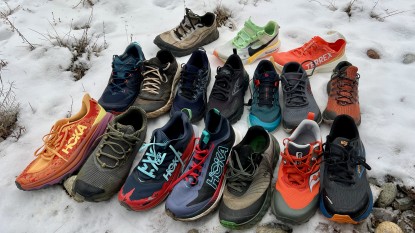Asics Gel-Kahana 7 Review
Our Verdict
Our Analysis and Test Results
While touted as a trail running shoe, the Asics Gel-Kahana 7 is more of a crossover shoe that will work well both on the roads and on trails, and is not nearly as well equipped to handle burly trail running as the Asics Gel-FujiTrabuco 4 Neutral. It incorporates the Gel cushioning system in the heel and DuoMax stability control in the heel and under the arch, but lacks a forefoot rockplate. These features give it a rigid and supportive feel through the back of the foot, yet a flexible and sensitive feel in the forefoot. This could be a great shoe for Asics lovers looking to transition from roads to trails, or for those who run on smoother dirt, but we can't recommend it when comparing it to the other options available for dedicated trail and off-road running.
Foot Protection
Without a rockplate and with a relatively low stack height of cushioning under the foot, the Gel-Kahana 7 does not give much protection to the bottom of the foot. Despite using Asics' Gel heel cushioning system, this shoe felt much less protective and cushioned than the FujiTrabuco 4 Neutral. There are gaps in the outsole designed to increase flexion, but the simple reality of this shoe is that you can easily feel what you are stepping on. Whether you like that or not, you be the judge.
Traction
The trail specific outsole on this shoe was amongst the lowest performers that we tested. The lugs are low profile compared to most and very closely spaced, a feature that leads to mud build-up. Additionally, the outsole is formed in many separate pieces glued to the SpEVA midsole, which is nowhere near as durable as a single sole piece. We saw reports online of the soles coming apart, and indeed this was beginning to happen to our test pair after less than 100 miles of use.
Stability
The Gel-Kahana 7 was middle of the road in terms of stability. Its 10mm heel-toe drop is amongst the largest in the test, a quality that we find leads to less stability in general. However, it rides higher off the ground and is nowhere near as stable as say the Mizuno Wave Kazan.
Comfort
Comfort is going to be a very subjective thing with this shoe depending on whether you need motion control in your shoes or not. The motion control feels similar to an orthotic insert that supports the inside of the foot in the heel and arch area. Our head tester prefers a neutral shoe, so found the motion control pretty uncomfortable. That said, he did not find any discomfort from the fit or construction of the shoe. One detraction to the comfort score of this shoe was the fact that it absorbed and then retained a lot of water during our bucket test.
Weight
The Gel-Kahana 7 weighs 26.2 ounces for a pair, ranking it amongst the heaviest in our review along the sides of the Gel-FujiTrabuco 4 Neutral and the Brooks Cascadia. Ignoring the scale and going by feel, it didn't feel prohibitively heavy to our testers.
Sensitivity
Similar to the New Balance Leadville 1210v2, this is a shoe that also foregoes the addition of a rockplate and instead uses EVA foam exclusively to protect the bottom of the foot. As a result, the Gel-Kahana 7 offers great trail feel. The forefoot articulates well, which is what makes it a good option for roads as well. The Gel system in the heel eliminates much of the heel sensitivity, but it is designed to cushion against heel-striking, and thus that is more important.
Best Applications
In our opinion, the Gel-Kahana 7 is a good shoe for someone who runs on both trails and roads but only has one pair of shoes, or someone looking to transition from roads to trails. For a dedicated trail runner, this is not the ideal shoe.
Value
The MSRP for this shoe is $85. While that makes it $10 more expensive than the Adidas Vigor 5, we feel it is a far superior shoe. For those getting into trail running or who need motion control, we think this shoe offers you good bang for your buck.
Conclusion
The Asics Gel-Kahana 7 is versatile and affordable shoe that offers runners with over-pronation issues a motion control midsole platform. Lacking a forefoot rockplate, it is one of the more sensitive shoes that we tested, and its supple and flexible feel make it a great choice for runners who spend a lot of time on both trails and roads.









